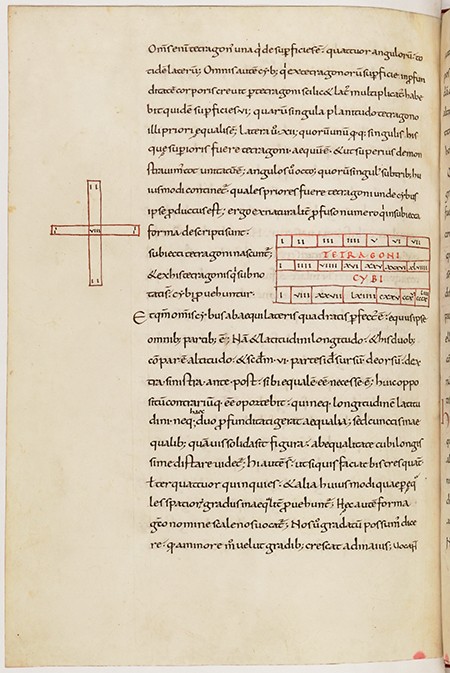Number was vested with divine authority throughout the Middle Ages. According to the Bible, the cosmos was wrought by a mathematically minded God who made all things by “number, measure, and weight” (Wisdom 11:21). Thus number was believed to be the ultimate basis of matter, and the medieval analogues of today’s sciences (for example, physics, biology, chemistry, medicine) were subject to mathematical precepts. Humans, moreover, were thought to possess an acuity for numeric order. Plato, in his Timaeus, a dialogue on the cosmos that undergirded much medieval and early modern scientific speculation, claimed that the “supreme good” of vision was the ability to “denumerate” (dinumerare in the Latin translation), meaning to discern number, count, or calculate (47a). For centuries, these truths governed everyday realities and significantly shaped how people apprehended and interacted with the material world. The book I have written at CASVA traces the ramifications of these twin axioms, exploring the nature of numeracy, its cultivation, and the quality of its effect on visual culture in Latinate Europe around the year 1000. Period artifacts evince a marked attention to quantity; interest in pattern, sequence, and placement; and emphasis on shape. I show how the success of this abstract pictorial repertoire was contingent on taught habits of body and mind cultivated in the era’s monastic and cathedral schools.
Education changed in the central Middle Ages, roughly the late ninth through the eleventh century. While the trivium, the arts of grammar, rhetoric, and dialectic, remained the foundation of learning, the quadrivium—arithmetic, geometry, astronomy, and music—received new emphasis. This shift is attested in the surge in production of late antique and early medieval tracts by such figures as Boethius, Calcidius, Macrobius, Martianus Capella, Isidore of Seville, and Bede, which composed the quadrivial canon. Pictures (including figures, tables, and complex schemata) were an integral and substantial part of these works. Copied and recopied, the texts changed little, but the pictures attracted annotation and underwent significant modification. Experimentation with placement, scale, color, and contours manifests a keen awareness of morphology, vision, and limits of representation that were themselves the product of numerate exploration. Pictures, in short, were the primary locus of scientific inquiry and vehicles of quadrivial instruction.
Though little known and almost unstudied today, quadrivial manuscripts were ubiquitous in the Middle Ages. My project is grounded in them. I focus on those that were produced, copied, and used at the cathedral of Reims and the monastery of Saint-Benoît-sur-Loire (Fleury), centers of numeric pursuit. The masters of these schools, Gerbert of Aurillac (later Pope Sylvester II; c. 940–1003) and Abbo of Fleury (c. 944–1004), gained renown for their mathematical prowess and charismatic teaching. They (and a handful of others) educated a generation of Europe’s powerful elites and a host of clerics, nuns, monks, and priests. In the relatively closed economy of the tenth and eleventh centuries, these men and women were the primary patrons, makers, and viewers of objects. All were numerate, and their numeracy had a demonstrable impact on contemporary imaging and imagining. Students of arithmetic became freshly attuned to quantity and form. While the study of time-reckoning and astronomy developed an agile eye capable of animation, the practice of geometry exercised the intellectual eye, sharpening it, according to Gerbert, “for contemplating spiritual things and truths.”
My work challenges established narratives in the history of science and of art and expands our notion of the visual scientific. Historians of all stripes have treated the central Middle Ages, especially the tenth century, as a period that witnessed the eclipse of the “hard sciences.” The twelfth century, when quantitative knowledge began to be assimilated from Arabic and Greek sources, is generally identified as the beginning of Western science in Europe. This conventional chronology emerged from a history of science bound up with the recovery of the classical past (the works of Aristotle, Archimedes, Euclid, and Ptolemy, among others) as well as the direct observation of nature. Guided by this narrow account, historians of art have de facto rarely looked to scientific paradigms to help explain representational trends in the early and central Middle Ages. We have thus failed to recognize the deeply intellectual roots of the period’s radical abstraction. Indeed, the chief characteristics of styles of the year 1000 and of the early Romanesque—the flattened forms, unmodeled and patterned surfaces, heavily delineated contours, nonspatial proportion, and intermingling of textual and graphic elements—have generally been deemed inimical to rational apperception. Yet pictures constructed to convey quantitative concepts reveal the same graphic tendencies. By questioning the appearances of rationality in the past, my project restores critical connections between artistic representation and scientific investigation.
